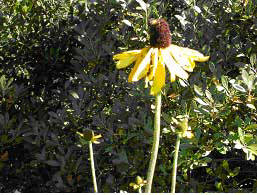 Every
spring I have a long to-do list. So many things to do
in the garden after a winter of being indoors, things
like visiting garden centers and nurseries to find
those new plants I was reading about in a gardening
magazine, or preparing a new bed, not to mention
mulching, mowing, weeding, planting a vegetable
garden......
Every
spring I have a long to-do list. So many things to do
in the garden after a winter of being indoors, things
like visiting garden centers and nurseries to find
those new plants I was reading about in a gardening
magazine, or preparing a new bed, not to mention
mulching, mowing, weeding, planting a vegetable
garden......
Then summer hits. Dead-heading
perennials and harvesting vegetables begins, weeding
never ceases and enjoying evenings with the kids while
watching the purple martins flying and singing become
the highlights of summer gardening.
Fall sets in. The temperatures
cool, sweaters and sweatshirts come out of the
closets, making s'mores by the outdoor fire on
Saturday nights become even more enjoyable. And what
about gardening? Is it over for the season? Not a
chance. Dividing spring and blooming perennials,
moving plants, and re-designing gardens are all
activities that can be accomplished this fall before
winter sets in.
Fall becomes a great time to
see your garden's structure. As leaves turn colors and
drop, a plant's bark and branching become dominant in
the landscape. Not only should you be looking at tree
and shrub branching structure, but also remnants of
perennials and grasses. Echinaceas, rudbeckia, and
native grasses come to life.
|

Rudbeckia
maxima |
Yes, echinaceas (purple
coneflowers) and rudbeckia (black-eyed susan) are
loved by birds before and after the flower petals
drop. Our stand of plants stays alive with bird
activity during the fall and winter months. We come
home at the end of the school and work day, and see
the finches feeding on the seeds of these flower
heads. Any variety will attract attention, but here
are some in my garden that are real winners.
Rudbeckia maxima, great
coneflower, grow to about 6 feet tall. The foliage is
a gray-green color and quite large. Each leaf can get
as long as 12 inches. The flowers have yellow petals
with a dark center, typical colors of rudbeckia. But
the petals droop, like an Echinacea. The center of the
flower elongates as the flower seeds ripen, and that
is what the birds really go for! Its big bloom time in
my garden is July-August, but it often will send up a
flower spike or two in late September.
There's tons of breeding work
being done on Echinaceas. Most of us know Echinacea
purpurea ' Magnus' and 'White Swan'. But the Big Sky
series has hit the markets big time this past season.
I tried 'Sunset' in my garden this year and was
pleased with its performance. It opens a
buttery-yellow then fades to a creamy color. The
petals are only slightly droopy, unlike White Swan and
Magnus, which are very droopy. It handled the wet
spring and dry summer very well, not appearing to be
at all affected, unlike some other perennials in the
garden. Next year I'll be planting E. x 'Sunset', also
part of the Big Sky Series. This coneflower boasts of
orange flower petals, one I'm anxious to try.
Another Echinacea I've had
great luck with, and is giving structure and life in
the fall and winter garden, is E. tennesseensis 'Rocky
Top'. This coneflower has a large, dark brown seed
center with purple petals that are flat, not drooping.
The flower petals are somewhat narrow and not as long
as E. purpurea. The leaves are narrow as well. It
reaches about 2 feet and blooms from July through
August. I had placed this grouping of plants in the
middle of my garden, and will be transplanting it in
the spring towards the front. Since the foliage is
narrow and not too tall, it has gotten lost, so
bringing it to the foreground should show it off a bit
more.
A grouping of plants for fall
and winter interest is the grasses. Many people are
unaware of the many kinds of native grasses that are
showy.
Indian grass and switch grass
are two native grasses that are underused in the
landscape. Indian grass, Sorghastrum nutans, is 3'-7'
tall, very erect, bunch type grass. The seed heads are
brown, flowering in July-September. It has a lovely
rust fall color.
Switchgrass, Panicum virgatam,
is a great native grass that provides not only cover
for wildlife but also food. The showy seed heads have
an "open" appearance, making them more interesting.
There are many cultivars of this particular native
species. 'Dallas Blues' has blue foliage, very showy.
Another more common blue cultivar is 'Heavy Metal'.
So don't give up on your
garden for the year. Plan for fall and winter interest
and keep on gardening!
Read other fall related gardening articles